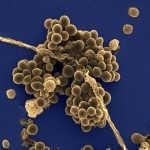Link to Pubmed [PMID] – 1962839
Mol. Microbiol. 1990 Sep;4(9):1513-21
Excision of Tn1545 and related conjugative transposons of Gram-positive bacteria occurs by reciprocal site-specific recombination between non-homologous regions of the transposon-target junctions. Excisive recombination requires two transposon-encoded proteins designated Xis-Tn and Int-Tn. We have shown that, following excision, Tn1545 is a circular structure with ends separated by either of the two hexanucleotides that were present at the transposon-target junctions. Using a trans-complementation assay, we have demonstrated that Int-Tn is able to catalyse in vivo integration of a circular intermediate of Tn1545 defective for integration and excision. comparison of integration sites suggests that limited sequence homology at the vicinity of the recombining sites is required for integration of the element. These data support the hypothesis that the integration/excision systems of conjugative transposons from Gram-positive cocci and of lambdoid phages from Gram-negative bacilli have evolved from a common ancestor.

